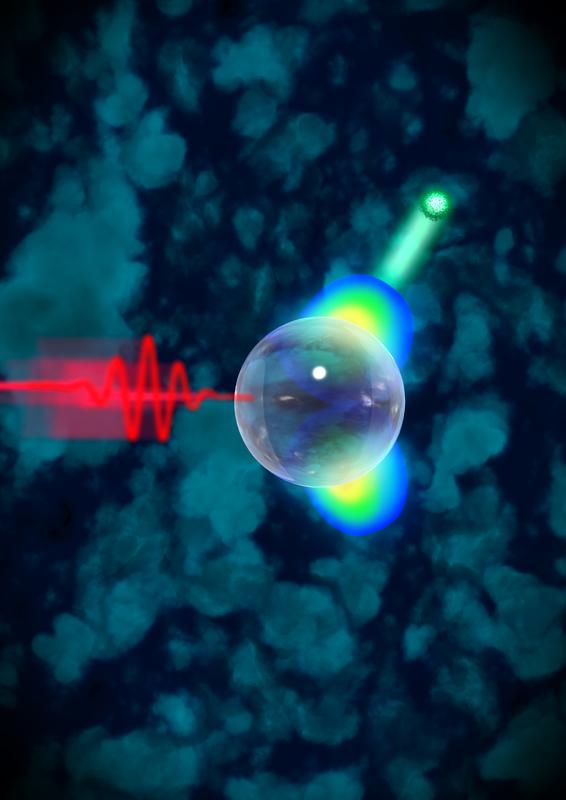Attosecond Electron Catapult

Directional electron acceleration on glass nanospheres. A femtosecond laser pulse (coming from the left) hits a glass nanosphere. The light releases electrons (green) from the group of atoms. Picture: Martin Dulovits/woogieworks
The relationship between strong laser pulses and glass nanoparticles is a special one – one that could influence medical methods, as scientists from Rostock, Munich, and Berlin have discovered. The interplay between light and matter was studied by a team of physicists and chemists from the Laboratory of Attosecond Physics (LAP) at the Max Planck Institute of Quantum Optics (MPQ) and the Ludwig-Maximilians-Universität Munich (LMU), from the Institute of Physics of the University of Rostock, and from Freie Universität Berlin.
The researchers studied the interaction between strong laser pulses and glass nanoparticles, which consist of multiple millions of atoms. Depending on how many atoms were contained in the nanoparticles, these objects reacted differently over attosecond timescales (an attosecond is a billionth of a billionth of a second).
Depending on their size, so called near-fields (electromagnetic fields close to the particle surface) were induced by the laser pulses, resulting in a controlled directional emission of electrons. These findings could eventually extend cancer therapy and imaging methods in medicine. The study was published in the latest issue of the journal Nature Communications.
Strong laser pulses have an extremely pronounced effect on nanoparticles. As soon as the atoms “feel” the electromagnetic wave of the light, their electrons start to oscillate. This produces near-fields at the surface of the particles. These near-fields have dimensions in the nanometer range, and oscillate in a characteristic fashion depending on the wavelength of the incident light.
Led by Prof. Matthias Kling, the LAP-physicists studied silica nanospheres with diameters of 50 to 550 nanometers, which were chemically synthesized in the research group around Eckart Rühl at Freie Universität Berlin.
The scientists let strong, approximately four-femtosecond-long laser pulses hit the group of atoms (a femtosecond is a millionth of a billionth of a second). As soon as the electromagnetic waves of the light field hit the nanospheres, near-fields formed at the surface and began to pulsate. The larger the light-irradiated spheres were compared to the laser wavelength (720 nanometers), the stronger the effect of the near-fields as an electron catapult.
The researchers observed this effect by using particle detectors to monitor the flight paths of electrons emitted from the near-fields of the nanospheres within the passage of the laser pulse. “The energy and direction of emitted electrons is strongly linked to the spatial and temporal structure of the near-fields. The emission of electrons is like a ping-pong game on the surface of the nanospheres that can be controlled with a precision of attoseconds,” explains Prof. Thomas Fennel from the University of Rostock.
He conducted simulations with his team, shedding light on the microscopic processes and their evolution in time. “First, the electrons leave the spheres, but they are then pulled back to their surface. After bouncing off the surface, they obtain a strong, final momentum kick from the near-field, which frees them from the nanoparticles,” Prof. Matthias Kling added.
Since the directional emission of particles can be controlled with this technique using laser light, the researchers argue that a long-term perspective could be medical applications. “With directional electron motion, strongly directed X-rays for imaging applications could be produced,” describes Prof. Eckart Rühl.
With sufficiently intense laser pulses, it may also be possible to release ions, which are charged atoms, from the nanocomposite, resulting in strongly directed ion radiation for cancer therapy. Furthermore, the technique might open up new perspectives for material processing beyond the diffraction limit – for instance in order to remove nanometer-sized areas from a surface.
The scientists also believe that the combination of strong light pulses and nanoparticles can become an important building block of future electronics. With so-called light wave electronics, one would be able to compute data at light wave frequency (about 1015 cycles per second): 100,000 times faster than currently possible. (Thorsten Naeser)
Original publication:
Field propagation-induced directionality of carrier-envelope phase-controlled photoemission from nanospheres.
F. Süßmann, L. Seiffert, S. Zherebtsov, V. Mondes, J. Stierle, M. Arbeiter, J. Plenge, P. Rupp, C. Peltz, A. Kessel, S.A. Trushin, B. Ahn, D. Kim, C. Graf., E. Rühl, M.F. Kling, T. Fennel.
Nature Communications, 12. August 2015, DOI: 10.1038/ncomms8944
(http://dx.doi.org/10.1038/ncomms8944)
Contacts for further information:
Prof. Dr. Matthias Kling
Ultrafast Nanophotonics Group, Laboratory for Attosecond Physics
Department of Physics, Am Coulombwall 1
85748 Garching, Germany
Phone: +49-89-32905-234
E-Mail: matthias.kling@physik.uni-munechen.de
Prof. Dr. Eckart Rühl
Institut für Chemie und Biochemie – Physikalische und Theoretische Chemie
Freie Universität Berlin
Takustr. 3
14195 Berlin, Germany
Phone: +49-30-838-52396
E-Mail: ruehl@zedat.fu-berlin.de
Prof. Dr. Thomas Fennel
Theoretical Cluster Physics and Nanophotonics Group
Institute of Physics, University of Rostock
18051 Rostock, Germany
Phone: +49-381-498-6815
E-Mail: thomas.fennel@uni-rostock.de
Media Contact
More Information:
http://www.uni-rostock.deAll latest news from the category: Physics and Astronomy
This area deals with the fundamental laws and building blocks of nature and how they interact, the properties and the behavior of matter, and research into space and time and their structures.
innovations-report provides in-depth reports and articles on subjects such as astrophysics, laser technologies, nuclear, quantum, particle and solid-state physics, nanotechnologies, planetary research and findings (Mars, Venus) and developments related to the Hubble Telescope.
Newest articles

NASA: Mystery of life’s handedness deepens
The mystery of why life uses molecules with specific orientations has deepened with a NASA-funded discovery that RNA — a key molecule thought to have potentially held the instructions for…

What are the effects of historic lithium mining on water quality?
Study reveals low levels of common contaminants but high levels of other elements in waters associated with an abandoned lithium mine. Lithium ore and mining waste from a historic lithium…

Quantum-inspired design boosts efficiency of heat-to-electricity conversion
Rice engineers take unconventional route to improving thermophotovoltaic systems. Researchers at Rice University have found a new way to improve a key element of thermophotovoltaic (TPV) systems, which convert heat…



